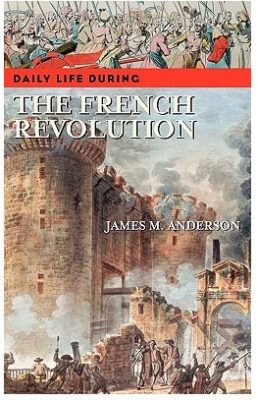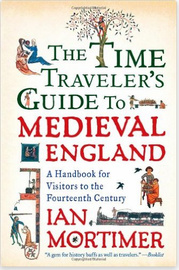

ANACHRONISM. A neglect or falsification, whether wilfully or otherwise, of strict chronological relation. Anachronisms may be committed in a great variety of ways, e.g., in painting, by representing members of the Holy Family in the costumes of the period at which the painter lived, as in many of the pictures of the old masters; on the stage, as in the last century when Alexander the Great appeared on the French stage in the costume of the time of Louis XIV. Anachronisms are sometimes deliberately introduced into historical novels and other similar works with a definite object, and this should always be taken into account in judging an author’s accuracy.*
On the advice of a respected culinary historian of my acquaintance, I read page 3 of the first volume of popular historical novelist Dorothy Dunnett’s Níccolò Rising series. Part of the story takes place on a dock in Bruges of 1460. Several characters begin unloading cargo from a sailing ship:
“On the other side of the boat, Julius helped throw up the ropes at the sea lock, and heaved up the statutory can of Bruges beer to the lock-keeper.”
Brewers did not sell beer in cans in 1460 Bruges! At least not like the cans of today, but that’s the image that comes across. The word, true, comes from Old English – spelled “canne” or “kanne” – and refers to tankard-like receptacles. The image of tossing a tankard also doesn’t work for me, but so be it.
I stopped reading right there. Then I later donated the book to Goodwill.
Dorothy Dunnett is not alone in writing great stories with culinary inaccuracies. Many historical novelists play fast and loose with the facts. After all, “artistic license” gives writers a great deal of leeway. And that’s not always a bad thing. The celebrated British writer, Hilary Mantel, whose novel Wolf Hall enthralled readers and won the coveted Man Booker Prize, veers widely from received wisdom about her time period, Tudor England. She says,
“It’s not possible to lay down a rule or a standard of good practice, because there are so many types of historical fiction. Some have the feel of documentary, others are close to fantasy. Not every author concerns herself with real people and real events.”
True.
“Artistic license” does indeed permit authors to stretch the truth, to commit sins of omission, and sins of commission, all in the name of storytelling and literature. However, sometimes discrepancies between truth and fiction result in obvious and cringeworthy anachronisms.
So how might you avoid food bloopers or confusing use of words like Dorothy Dunnett’s can in your historical novel? Or how might you avoid using a word whose meaning has changed over the centuries?
To zero in on culinary accuracy:
- Remember the Columbian Exchange and the crucial date of 1492. Prior to the voyages of Christopher Columbus, many foods – including chocolate, pumpkins, potatoes, and tomatoes– were unknown outside New World cuisine. And several decades, if not centuries, passed before people accepted some of these foods in their daily diet.
- Consult Lynne Olver’s Food Timeline. It goes far beyond the idea of a timeline and provides details about period cooking, dietary beliefs, and culinary equipment and techniques.
- Access historic menu collections at the New York Public Library and the Los Angeles Public Library. Prior to the 18th century, written menus per se did not exist.

- Read cookbooks pertinent to your novel’s time period. You’ll find digitized versions of many cookbooks online. To benefit most from reading old cookbooks, follow culinary historian Barbara Ketchum Wheaton’s structured approach. Track down some essential bibliographies, mostly American and English works.
- Study material culture of the historical kitchen. Material culture signifies wealth, social class, and technological achievement. A good resource for this is The Encyclopedia of Kitchen History. Examine displays of glassware, serving dishes, and the like in museums and historic homes. Paintings, such as those by Dutch artist Pieter Aertsen, also provide visual clues that may be of use to you, depending upon your novel’s time period. Look at photographs, too. A caveat: artists and photographers often embellished their work at the request of their patrons, so take what you see with a grain of salt.
- Seek out historical maps. Several collections such as the Perry-Castañeda Library Map Collection exist online. Maps will give you a boost with placing markets and other culinary landmarks in the correct location and time period.
- Familiarize yourself with agricultural and food-processing practices common during your time period. ABC-Clio/Greenwood Press publishes a series worth looking at: Daily Life Through History (54 titles, ranging from daily life in ancient times to Native American life in the 20th century).
- Use Wikipedia with caution. Double check, double check, double check. Everything.
- Avoid using other contemporary historical novelists as sources. Chances are they’ve all read the same misinformation, passing on “fakelore.”
- Resist relying 100% on the Internet. Look for books such as Ian Mortimer’s Time Traveler’s Guide to trilogy, which concern Medieval, Elizabethan, and Restoration England.

And remember that no matter how much you research, you’re bound to get something a bit skewed. Think of Jane Austen’s Emma. In Chapter 42, Jane includes a passage where an apple tree blooms out of season:
“It was a sweet view — sweet to the eye and the mind. English verdure, English culture, English comfort, seen under a sun bright, without being oppressive…It might be safely viewed with all its appendages of prosperity and beauty, its rich pastures, spreading flocks, orchard in blossom, and light column of smoke ascending.”
Despite her brother Edward’s protestations that apple trees blossom in May, not June, Jane retained that text in subsequent editions, which now number in the dozens, if not more.
In the end, story matters most. But it still pays to verify the telling details, the facts.
______________________
*From Arnold James Cooley’s Cooley’s Cyclopædia of practical receipts and collateral information in the arts, manufactures, professions, and trades, including medicine, pharmacy, and domestic economy: designed as a comprehensive supplement to the pharmacopœia and general book of reference for the manufacturer, tradesman, amateur, and heads of families., J. & A. Churchill, 1892, p. 122.

Wendy Thornton
Great article – very helpful. I especially love that last line: In the end, story matters most. But it still pays to verify the telling details, the facts.
Cynthia Bertelsen
Thanks, Wendy. Yes, ultimately it’s story that keeps the reader hanging in there.
Mary Bast
Fascinating. I’ve found it can also be fun to research and include culinary information in our writing. Some years ago I was writing a poem about Shakespeare’s marriage and had photos of the Stratford-Upon-Avon dwelling and copies of his plays, but wasn’t sure what his meals might have been like. One of the verses I created from that lovely trip into history (which also incorporates lines from his plays) reads:
“Mayhap their celebration feast entailed
the preparation of a leg of mutton
minced and rolled in poppet balls —
mace, cloves, dates, currants:
Fartes of Portingale.
‘Now for the bare-picked one of majesty. . .’
the culinary phantasm of pie,
perchance, its opening to wild applause,
releasing six live finches, ‘so delight
and pleasure shew the company.'”
Cynthia Bertelsen
Mary, great poem!
Ann-Marie Magné
What a great blog piece. I am inspired to read Mortimer’s guides. Fortunately for me, in my memoir the only culinary accuracy I have to worry about is hospital food and Ruby Tuesday’s. I especially remember that one meal served with a can of 1460 Bruges beer. . .
Cynthia Bertelsen
Ann-Marie, hospital food really sticks in the mind, if not the stomach, doesn’t it?
John Waaser
I once downgraded a book, in a review, because the author had just referred to 1954 cars as brand new, and then said that something had just come over the UP newswire. I was fairly certain that United Press didn’t merge with International News Service until several years later, so I looked it up online. That did not happen until 1958. The author tried to defend himself by saying that the story took place in the late fifties. Not if 1954 cars were brand new, it didn’t!
John Waaser
Oops, looks like autocorrect changed UPI to UP. Yup, it tried it again just now, but I caught it. The book referred to the UPI Newswire, not the UP Newswire!
John Waaser
Oops, looks like autocorrect changed UPI to UP. Yup, it tried it again just now, but I caught it. The book referred to the UPI Newswire, not the UP Newswire! UP or INS would have been correct in 1954, UPI was not correct.
Cynthia Bertelsen
John, it’s little things, isn’t it? Alas, no matter how much writers try, something is probably going to slip by.